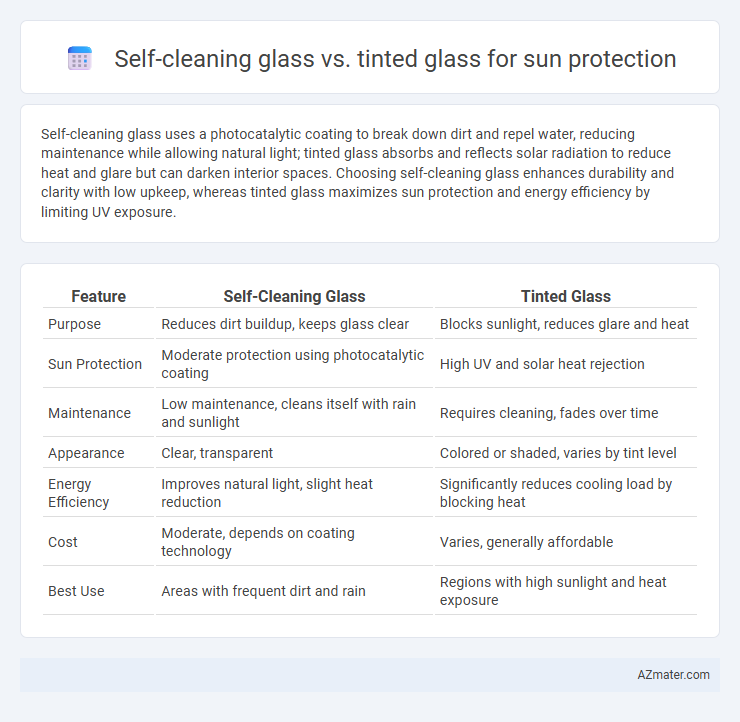Self-cleaning glass uses a photocatalytic coating to break down dirt and repel water, reducing maintenance while allowing natural light; tinted glass absorbs and reflects solar radiation to reduce heat and glare but can darken interior spaces. Choosing self-cleaning glass enhances durability and clarity with low upkeep, whereas tinted glass maximizes sun protection and energy efficiency by limiting UV exposure.
Table of Comparison
| Feature | Self-Cleaning Glass | Tinted Glass |
|---|---|---|
| Purpose | Reduces dirt buildup, keeps glass clear | Blocks sunlight, reduces glare and heat |
| Sun Protection | Moderate protection using photocatalytic coating | High UV and solar heat rejection |
| Maintenance | Low maintenance, cleans itself with rain and sunlight | Requires cleaning, fades over time |
| Appearance | Clear, transparent | Colored or shaded, varies by tint level |
| Energy Efficiency | Improves natural light, slight heat reduction | Significantly reduces cooling load by blocking heat |
| Cost | Moderate, depends on coating technology | Varies, generally affordable |
| Best Use | Areas with frequent dirt and rain | Regions with high sunlight and heat exposure |
Understanding Self-Cleaning Glass: Features and Benefits
Self-cleaning glass incorporates a photocatalytic coating that breaks down organic dirt when exposed to sunlight, reducing the need for manual cleaning and maintaining clarity. Its hydrophilic surface allows water to spread evenly, washing away loosened debris and enhancing visibility while providing effective UV protection. This innovative technology not only improves building aesthetics but also lowers maintenance costs and energy consumption by optimizing natural light use.
What Is Tinted Glass? An Overview
Tinted glass is a type of window glass treated with additives or films that absorb or reflect a portion of solar radiation, reducing heat and glare inside buildings or vehicles. It provides sun protection by minimizing ultraviolet (UV) rays penetration while enhancing privacy and energy efficiency. Compared to self-cleaning glass, tinted glass prioritizes solar control and interior comfort, making it ideal for sun protection applications.
How Self-Cleaning Glass Works Against Sun Exposure
Self-cleaning glass utilizes a photocatalytic coating, usually titanium dioxide, which activates under sunlight to break down organic dirt and pollutants, effectively maintaining clarity and enhancing solar heat control. This coating also creates a hydrophilic surface that allows rainwater to spread evenly, washing away loosened debris and reducing dirt accumulation that could increase heat absorption. Compared to tinted glass, self-cleaning glass ensures better natural light transmission while providing a cleaner, more efficient barrier against solar radiation and glare.
The Science Behind Tinted Glass Sun Protection
Tinted glass reduces sun exposure by absorbing and reflecting specific wavelengths of ultraviolet (UV) and infrared radiation, thereby limiting heat transmission through the glass. This is achieved through the incorporation of metal oxides or dyes during the manufacturing process, which selectively filter solar energy without significantly compromising visible light transmission. Unlike self-cleaning glass, which primarily relies on photocatalytic coatings to break down organic dirt, tinted glass is engineered to optimize thermal comfort and protect interiors from UV damage through its spectral control properties.
UV Protection Comparison: Self-Cleaning vs Tinted Glass
Self-cleaning glass incorporates a special photocatalytic coating that helps break down organic dirt under UV light but provides minimal UV protection compared to tinted glass. Tinted glass significantly reduces UV radiation by absorbing and blocking harmful rays, thereby offering superior sun protection and preventing interior fading. Choosing tinted glass is more effective for UV protection, while self-cleaning glass primarily enhances maintenance and clarity.
Heat Reduction Efficiency: Self-Cleaning Glass vs Tinted Glass
Self-cleaning glass offers moderate heat reduction by reflecting some solar radiation through its hydrophilic coating, promoting cleanliness but not significantly blocking infrared heat. Tinted glass excels in heat reduction efficiency by absorbing and reflecting a larger percentage of solar infrared rays, thereby minimizing heat transfer and lowering indoor temperatures. For superior sun protection and thermal comfort, tinted glass provides more effective heat reduction compared to self-cleaning glass.
Maintenance and Longevity: Which Glass Type Lasts Longer?
Self-cleaning glass features a special titanium dioxide coating that breaks down organic dirt and allows rainwater to wash it away, significantly reducing maintenance efforts compared to tinted glass, which requires regular cleaning due to visible dirt and smudges. While tinted glass blocks solar heat and UV rays effectively, its durability can be compromised by fading or discoloration over time from exposure to sunlight and weather elements. Self-cleaning glass tends to maintain its functionality and appearance longer, offering superior longevity and lower upkeep costs for sun protection applications.
Energy Savings: Impact on Cooling Costs
Self-cleaning glass reduces the need for manual cleaning and maintains optimal solar heat control by keeping the surface clear of dirt, enhancing natural light penetration and reducing reliance on artificial lighting and cooling. Tinted glass directly lowers solar heat gain by absorbing and reflecting sunlight, significantly reducing indoor temperatures and decreasing air conditioning energy consumption. Both technologies contribute to energy savings, but tinted glass typically offers more immediate and measurable reductions in cooling costs due to its solar control properties.
Aesthetic Differences: Visual Appeal and Design Options
Self-cleaning glass offers a sleek, transparent surface that maintains clarity and brightness, enhancing modern architectural aesthetics with minimal maintenance. Tinted glass provides a variety of shades and colors, allowing customizable design options that influence building appearance while reducing glare and heat. Both types contribute uniquely to visual appeal, with self-cleaning glass emphasizing pristine clarity and tinted glass offering versatile stylistic choices for sun protection.
Choosing the Right Glass for Sun Protection: Key Recommendations
Self-cleaning glass utilizes a photocatalytic coating to break down organic dirt and rainwater to wash it away, enhancing clarity and reducing maintenance while offering moderate solar heat gain reduction. Tinted glass incorporates colored additives or coatings to significantly reduce solar radiation and glare, providing superior ultraviolet (UV) protection and energy efficiency for sun-exposed environments. For optimal sun protection, select tinted glass for maximum heat rejection in hot climates and self-cleaning glass for low-maintenance facades with moderate sun exposure.

Infographic: Self-cleaning glass vs Tinted glass for Sun protection
 azmater.com
azmater.com